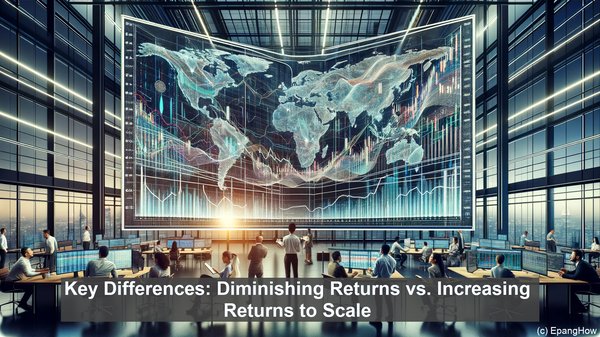Introduction: The World of Economics
Hello, everyone! Welcome to our article on the intriguing world of economics. Today, we’ll delve into the concepts of diminishing returns and increasing returns to scale, two fundamental ideas that shape economic decision-making.
Diminishing Returns: The Law of Diminishing Marginal Productivity
Diminishing returns, also known as the law of diminishing marginal productivity, is a principle that states that as more and more units of a variable input are added to a fixed input, the marginal output produced by each additional unit of the variable input will eventually decrease. In simpler terms, it means that the initial increase in output achieved by adding more resources will eventually taper off, and at a certain point, it might even lead to a decline in productivity.
Understanding Diminishing Returns with an Example
Let’s consider a scenario where a bakery is producing cakes. Initially, as more bakers are hired, the output of cakes increases rapidly. However, after a certain point, adding more bakers might lead to overcrowding in the kitchen, resulting in a decrease in efficiency. The bakers might start getting in each other’s way, and the overall output might not increase proportionally to the number of bakers added. This is a classic example of diminishing returns.

Increasing Returns to Scale: The Power of Proportional Growth
On the other hand, increasing returns to scale refers to a situation where, as all inputs are increased proportionally, the output increases at a higher rate. In simpler terms, it means that when a firm expands its operations, it can achieve a more than proportional increase in output. This can be attributed to various factors, such as economies of scale, better resource allocation, and enhanced specialization.
Visualizing Increasing Returns to Scale
Imagine a car manufacturing company. Initially, when the production is at a smaller scale, the costs per unit might be higher. However, as the company expands, it can benefit from bulk purchasing, streamlined processes, and division of labor. This leads to a significant reduction in costs per unit, resulting in increased profitability. The company’s output grows at a faster rate than the increase in inputs, showcasing the concept of increasing returns to scale.

Key Differences: Diminishing Returns vs. Increasing Returns to Scale
While both diminishing returns and increasing returns to scale deal with the relationship between inputs and outputs, there are some crucial distinctions. Diminishing returns focuses on the impact of adding more units of a variable input to a fixed input, leading to a decrease in marginal productivity. Increasing returns to scale, on the other hand, emphasizes the advantages of expanding all inputs proportionally, resulting in a more than proportional increase in output. Additionally, while diminishing returns is often associated with the short run, increasing returns to scale is a concept that is more relevant in the long run.
